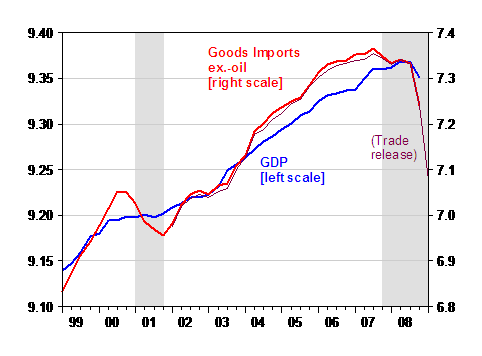The Collapse in Relation to GDP
In an earlier post, I discussed the startling decline in US imports [0]. Brad Setser has also reported on this phenomenon. This decline is not restricted to the United States, as noted in an OECD report released last week (h/t Torsten Slok):
Category Archives: international
The Decline in US Imports
I’ve been thinking about trying to convey exactly how startling the drop in U.S. imports has been. First, take a look how much non-oil goods imports (in real terms) have dropped, relative to, for instance, GDP.

Figure 1: Log GDP (blue, left scale), log goods import ex.-oil from NIPA (red, right scale), estimated from trade release (purple, right scale), all in Ch.2000$, SAAR. 2009q1 estimate is based on actual January and February data and March estimate incorporating continued 5% decline from February. NBER recession dates shaded gray. Source: BEA, GDP final release of 26 March 2009, February trade release, NBER, and author’s calculations.
Guest Blog: The Enduring Trilemma
By Hiro Ito
Today, we’re fortunate to have Hiro Ito, Associate Professor of Economics at Portland State University as a guest blogger.
While the current global crisis does not show any sign of bottoming out, policy makers around the globe are reevaluating international macroeconomic policies and discussing the post-crisis future of the international financial architecture — as we saw in the recent G20 meeting.
A New Meme: Blame It on Beijing (and Seoul, and Riyadh…)
Perhaps I’m overstating it, but I think this is the abridged version of the Bush Administration’s perspective on how we got into the financial mess we find ourselves in. You might ask why I focus on the ideas of the outgoing government. Well, it’s because I’m confident that this will be a thesis pushed by some commentators eager to absolve previous policymakers of blame [1]. And indeed (as Mish points out), this view has apparently adherents in high places.
The Startling Dropoff in Trade Flows
International Imbalances: Measurement and Implications
Paul Kedrosky has observed that a statistical analysis (word cloud) of the American Economic Association session titles, or even of the papers, leads to the impression that the economics profession has been relatively uninterested in the ongoing financial and economic crisis. Unfortunately, this observation misses ignores the fact that session proposals are submitted a full eleven months ahead of the ASSA meetings. Think back to January 2008, and the terms ascribed to those who warned of a severe slowdown (“alarmist”, etc.), and the whole discussion is cast in a different light.
“Trade finance is collapsing”
…said Victor K. Fung, the chairman of the Li & Fung Group, the giant supply chain management company that connects factories in China with retailers in the United States and Europe. “We’ve got orders we can’t ship right now.”
Source: “As Trade Slows, China Rethinks Its Growth Strategy,” NYT Jan 1, 2009.
Aggregate Demand and Finance and the Collapse in Trade
From “Trade-Finance Pinch Hurts the Healthy,” WSJ, 12/22/08:
The global financial crisis is drying up the financing that firms depend on for trade. That’s making the global recession nastier and deeper than it otherwise would be.
As with all kinds of credit these days, financial institutions are making less trade finance available and charging more for it. But the squeeze in trade stands out because it pinches otherwise healthy companies that should be driving a recovery in global commerce. Already, the World Bank predicts trade will contract next year for the first time since 1982.
ZIRP and the exchange rate…and other macro variables
Several months ago, I discussed the implications of a model of the exchange rate wherein Taylor rule fundamentals — the output [0], inflation and exchange rate gaps — were central (post). In that paper [pdf], I showed that Taylor rule fundamentals outperformed purchasing power parity, interest rate parity, and the monetary model of exchange rates in terms of in-sample fit, at least insofar as the dollar/euro exchange rate is concerned.
Measuring Import Prices: Implications for GDP Growth
A lot of what has happened to GDP growth over the past few quarters has, in a mechanical sense, depended upon developments in the external accounts. In this post, I examine whether mismeasurement of import prices might have induced mismeasurement of economic output. This idea was prompted by hearing a presentation of Nakamura and Steinsson a couple months ago. The abstract to “Lost in Transit: Product Replacement Bias and Pricing to Market”: